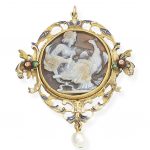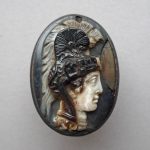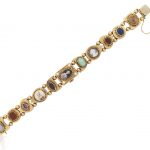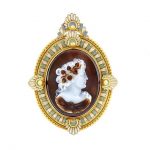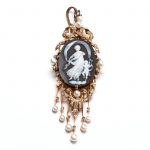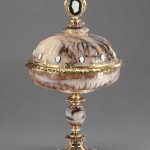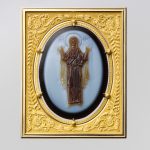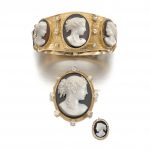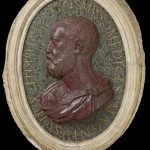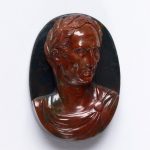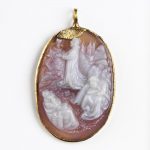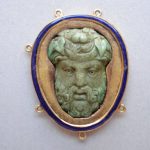Hardstone is not really a gemstone but a term used to describe many different gemstones. Hardstone carving is the three-dimensional carving for artistic purposes of semi-precious stones such as jade, agate, onyx, rock crystal, sard or carnelian, and a general term for an object made in this way. Two-dimensional inlay techniques for floors, furniture and walls include pietre dure, opus sectile (Ancient Roman), and medieval Cosmatesque work – these typically inlay hardstone pieces into a background of marble or some other building stone. Reference: Wikipedia.
A Neo-Renaissance gold, enamel, hardstone cameo and pearl pendant, 19th century The circular hardstone cameo, carved in low relief to depict the Goddess Juno seated in a chair, with one arm around a peacock, possibly 16th-17th century, within a scrolling gold frame with floral and foliate motifs, decorated in polychrome enamel, suspending a 7.0mm x 6.2mm pearl drop, pearl untested, some enamel loss, length 6.5cm
Sold for £ 5,625 inc. premium at Bonhams in 2017
Cameo; hardstone, sardonyx?; profile head of Minerva; set in metal mount with small ring at back; chip out of background on right, replaced with metal.
Reference: © The Trustees of the British Museum
Watch with manual movement, silver tone dial with arrow and dot markers, within a yellow gold rectangular case with hinged cover set with a painted cameo and 4 cultured pearls, on a slide charm bracelet set with painted and mother of pearl cameos, carved hard stones, faceted and cabochon gemstones Metal: 14k yellow gold Stones: carved mother of pearl and carnelian, faceted amethyst, garnet and quartz, cabochon hard stones Size/Dimensions: 18 cm, case 14.8 x 19 mm Signature: LE TOILE Marks: 14k, SWISS Gross Weight: 41 grams
Sold for USD 1000.00 at Christies in 2018
Antique Gold, Hardstone Cameo and Enamel Pendant-Brooch Centering one oval brown and white agate cameo depicting the profile of a lady, approximately 33.0 x 26.0 mm., surrounded by green and white enamel plaques, quartered by shell plaques, edged by twisted gold wire and beading, circa 1880, minor enamel loss, approximately 13.2 dwts.
Cameo: nice carving, translucent, good luster. Minor enamel loss and pitting. Several minor dings on reverse of gold frame. 2 5/16 x 1 3/4 inches.
Sold for $2,500 (includes buyer’s premium) at Doyle New York in 2018
Antique Gold, Diamond, Pearl, and Hardstone Cameo
A carved hardstone cameo depicting a frolicking woman and child, set in a gold mount with a bow motif surmount and suspending multiple tendrils below detailed with pearls and with rose cut diamond accents weighing approximately 1.73 total carats, testing 14KT and with a maker’s mark of an A superimposed over a V.
Sold for $800 at Leland Little Auctions in 2018
This bowl, which entered the collection of Louis XIV (1638-1715), is made up of two agate bowls set off by an enameled gold mount. The stone was cut in the late 14th century or early 15th century, and the mount added in 1571. The bowl illustrates the burgeoning taste for hard-stone objects in the 15th century.
The bowl itself and the lid are in fact reused small bowls without feet. The collection of Lorenzo de’ Medici (the Magnificent) included a large number of these round, shallow bowls in hard stone. The bowl itself is made of agate, with molding in relief, and the lid is of brown agate. These two elements were later embellished with a decor in relief when the mount was added. This sculpted ornamentation consists in projecting, flat-edged gadroons alternating with discontinuous friezes of piastres. Around the lid run two rows of eleven oval cameos of the twelve Caesars, but there was not enough room to feature them all. Two other cameos adorn the handle: these depict Augustus and Caligula but are not part of the same series.
In the late 13th century, two centers of production came to the fore and remained preeminent until the end of the Middle Ages: Paris and Venice. The hard-stone vases and bowls of the 14th and 15th centuries were thick and modeled on the lines of contempory gold- and silverwork. From the mid-15th century on, craftsmen began to design hard-stone objects made up of several pieces of the same stone or of different stones assembled with a gold- and silverwork mount. There are mentions of hard-stone vessels in the inventories of Charles V and his brothers, the dukes of Berry and Anjou. This taste for objects made of precious and semiprecious stone endured until the 16th century and through the 17th century. New mounts were made for older vessels, as in the case of this bowl.
Reference:The Louvre
Agate cameo of the Virgin and Child
This delicately carved cameo shows the Virgin in an orant pose, with her arms upraised, and a medallion of the Christ Child over her chest. This icon type is often called the Blachernitissa after a famous icon at the Blachernai Monastery in Constantinople.
Reference: The Metropolitan Museum of Art
Gold and hardstone cameo demi-parure, 1890 Comprising: a bangle of seven agate cameos depicting the profiles of classical maidens within a Greek key and circular-cut diamond surround and a brooch and pendant of similar design, bangle inner circumference approximately 170mm.
Sold for 6,250 GBP at Sothebys in 2017
Relief in porphyry set on an oval slab of serpentine (verde di Prato). The bust is shown turned three-quarters to the left with the head in profile. Cosimo wears a mantle over armour and fastened at the shoulder with a clasp. Round the edge of the background runs the inscription in incised gilt letters COSMVS MEDICES MAGNIVS DVX HETRVRIAE. In an oval moulded frame of white marble with faint traces of gilding. The frame is in four sections.
This relief was acquired in Florence in 1864 together with an eighteenth-century sedan chair used by the the Medici Grand Dukes (10-1864). Four years earlier Tuscany had been annexed to the Kingdom of Sardinia, and from 1861 Victor Emmanuel ruled in Florence as King. At such a time it is likely that many opportunities arose where objects from the Medici collections came onto the market, and this relief, although heavy, is not unmanageably bulky. Historical significance: Tadda’s series of low relief Medici portraits, such as this example, demonstrate how he exercised his design sense, and illustrate the artistic goals he set for himself as a porphyry carver. In 1570, a year after Cosimo I was conferred the title of Grand Duke, Tadda completed this relief portrait of him, carving his own name boldly into its truncation. His signature suggests that he hoped to associate himself with the fame of Duke Cosimo and indicates the pride he took in the relief’s technical and design merits. Like cameo-carvers who maximised the irregularities of shape and colouring in their stone, Tadda has exploited the contour and thickness of this particular porphyry fragment to accentuate specific features and create the kind of high relief effects favoured by medallists (See Pope-Hennessy, 1964). By setting the strong shape of Cosimo’s overmantle at an angle to the ground and balancing it below with a strongly projecting truncation, he creates a sense of containment for the profile and relates the whole head nicely to its oval ground. But, in adapting the design details to the structural idiosyncrasies of the stone, he employed very specific tools and embarked on new ways of varying the surface texture.
Reference: © Victoria and Albert Museum
Julius Caesar (101-44 BC) was honored as an icon of Roman military might and rule. This cameo could have been made as an individual object or as one of the Twelve Caesars. The artist took advantage of the layers of red and dark green in the jasper for this relief (cameo) carving.
Reference: The Walter Art Museum
